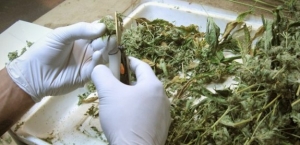Science for stoners: Here’s how pot works
Explaining the chemistry behind medical marijuana that got Sanjay Gupta and others to finally believe
BY K.M. CHOLEWA
Last week, CNN’s Dr. Sanjay Gupta grabbed headlines for coming out in support of the validity of the medical use of marijuana, something he had opposed in the past. What changed his mind? Science.
Here’s what he — and those studying the chemistry of marijuana — now understand.
Marijuana makes chemical contact with human bodies through cannabinoids, which are chemical compounds in marijuana (cannabis). The human body also creates cannabinoids. The body creates cannabinoids on-demand, such as when they are produced to serve as neuroprotectants when the brain’s nerve cells begin to fire too much, as in the case of stress, seizures or an impact to the brain. Our bodies also have cannabinoid receptors. Together, the cannabinoids and their receptors make up the human cannabinoid system.
Just as there was a time when we didn’t know we had immune systems or hormonal systems, until 1988 we didn’t know that we had cannabinoid systems.
The human body produces and utilizes its own cannabinoids, but the body can also utilize cannabinoids from external sources. One source of exogenous cannabinoids is marijuana, or to use marijuana’s botanical name, cannabis. Because these cannabinoids are plant-based, they would be considered phytocannabinoids. Phytocannabinoids from marijuana fit nicely into human cannabinoid receptors. Thus, the cannabinoids from the cannabis plant can be utilized by the human cannabinoid system.
Any woman who has had a hot flash can find an analogy in the hormone estrogen. As the process of menopause ensues, a woman’s estrogen level drops. Many women seek to balance their hormonal systems by taking in plant-based estrogens, phytoestrogens, such as soy or yams.
Other women, during menopause, seek to balance their hormonal systems through the use of a synthetic estrogen (rather than a plant-based one) such as with the pharmaceutical Premarin. Likewise, one can take in synthetic cannabinoids through the pharmaceutical Marinol.
So, in this analogy, pot is to a yam what Marinol is to Premarin.
One of the cannabinoids in cannabis – THC (delta-9-tetrahydrocannabinal) — creates a euphoric effect. The other 65 cannabinoids in cannabis do not. CBD (cannabidiol) is another cannabinoid in cannabis. In Gupta’s report, Charlotte Figi, the 6-year-old whose seizures were dramatically reduced by using marijuana, was using a strain of the plant high in CBD. Despite marijuana’s classification as a schedule 1 drug, meaning no medicinal applications, in 2003, the U.S. federal government patented CBD for medical use. CBD has medicinal applications in conjunction with THC, but also independently of it.
Cannabinoids are generally considered inhibitors. They damp down neurotransmitter release. But this doesn’t mean they necessarily damp down neural activity. If you inhibit an inhibitor, you get a release.
The big risk with many drugs and pharmaceuticals is respiratory and/or cardiovascular failure. Not so with cannabis. Numerous sources cite the lethal dose of marijuana at 40,000 times greater than the dose it takes to create the euphoric effects. It may be that there are no fatalities from marijuana use because there are no cannabinoid receptors in the medulla oblongata, the part of the brain stem responsible for respiratory and cardiovascular function.
The human body’s cannabinoid receptors provide places for cannabinoids — human-made, plant-base, or synthetic – to “plug in.” The cannabinoid receptor was discovered by Alan Hewitt in 1988. Raphael Mechoulam discovered the first cannabinoid, anandamide, in 1992. Anandamide, a cannabinoid made by the body, affects the same functions as the plant-based cannabinoid THC does: memory, pain, focus, etc.
There is evidence that anandamides are necessary to forget conditioned fear and trauma.Mice engineered to be unable to access their anandamides (cannabinoids produced by their bodies) were unable to get over a negative association to a nonthreatening input, specifically, a tone associated with an electric shock. Even when the electric shock no longer accompanied the stimulus, the mice maintain the conditioned stress response. Without a functioning cannabinoid system, they were biologically unable to “get over it.”
Mice in the control group (those who retained their access to their anandamides) in time no longer responded with stress to the tone, once the shock was uncoupled from it. They could hear the tone without experiencing the stress response. They got over it. They “unlearned” it, biochemically. When THC (a plant-based cannabinoid) was administered to the mice unable to access their own cannabinoids, those mice were able to “forget” the negative association, too, just like the mice in the control group who were never cut off from their bodies’ own cannabinoid systems.
“Human cannabinoid receptors are extremely similar to those found in rodents,” says professor of pharmacology Leslie Iverson in “The Science of Marijuana.” In humans, the analogy lies in the biochemistry of post-traumatic stress disorder. With PTSD, it is recognized that a person can be conditioned to respond as though his or her life is at risk every time there’s a loud noise; for example, as occurs in war zones. Even outside the war zone, conditioned associations are made, such as being conditioned to respond with stress, as if violence is imminent any time an authority figure gets frustrated, if one grew up in a home where a parent responded to frustration with violence.
Out of the war zone, or as an adult at work, these responses don’t make sense. They are no longer responses to reality, i.e., real threats. Uncoupling that fear response from the stimulus appears to involve the cannabinoid system. This uncoupling could be called “forgetting.” It is different than repression as repression keeps the faulty association active, though unconscious. Forgetting circumstantial, conditioned associations is critical to our capacity to read reality. Conditioned responses, though they perhaps at one time made sense, were “true” in reference to one’s experience, become maladaptive with a change in context. Forgetting is not the failure of mental function. It is a mental function. In the body, “forgetting” can represent the capacity to “unlearn” a biochemical pattern.
The ability to “unlearn” is necessary for change. Whether we call it unlearning, forgetting or deprogramming, dislodging the entrenched – in our minds, bodies or culture – requires accurate assessments of reality. When it comes to marijuana, the larger Drug War and the institutions built up around it, Dr. Gutpa’s message is another shot at a citadel constructed on misinformation and that shot comes straight from the mainstream of America.
K.M Cholewa has worked as a political writer, policy consultant and lobbyist in Montana for 22 years, including on issues related to medical marijuana. Her novel, Shaking Out the Dead, is due out Spring 2014.MORE K.M. CHOLEWA.


